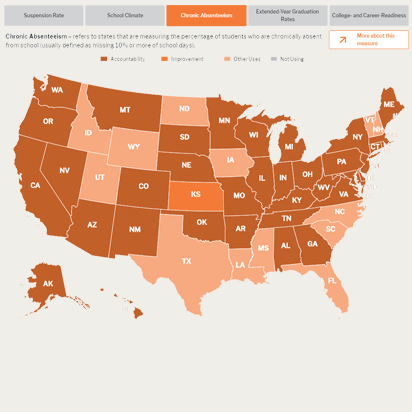Monitoring Chronic Absence Is Key to Creating an Equal Opportunity to Learn

This blog is part of the series, Realizing ESSA’s Promise, which provides insight into ESSA’s impact on students and schools.
In the 2012–13 school year, Connecticut educators and policymakers launched a comprehensive effort to track and address chronic absences across the state’s k–12 school system. The forward-looking effort was launched several years before states began adding chronic absenteeism as their nonacademic (fifth) indicator under the Every Student Succeeds Act (ESSA). Since prioritizing the issue, Connecticut has decreased the number of chronically absent students statewide by nearly 10,000 students overall and for every subpopulation of students. Graduation rates have also risen during the same time period. The state’s progress offers concrete proof that reductions in chronic absences can be achieved when policy is combined with strong support for implementation.
Six strategies have been key to Connecticut’s progress: 1) building awareness; 2) using data to promote action; 3) cultivating champions to build a state-level infrastructure; 4) building capacity throughout the system; 5) identifying and leveraging bright spots; and 6) fostering accountability. A key component of the statewide reductions was the passage of state legislation (Public Act 15-225) in 2015, which required district and school-level attendance teams to be established in areas in which chronic absence rates are high. The legislation also required the Connecticut Department of Education (CDE) to develop a prevention and intervention guide for chronic absenteeism for districts and schools that includes definitions, examples of root causes, local intervention models, strategies for districts and schools, and links to national resources. The state’s Next Generation Accountability System includes chronic absenteeism as one of 12 indicators designed to provide a holistic view of student and school performance.
A Persistent Challenge Nationwide
Chronic absence is a nationwide challenge affecting students in every setting: rural, suburban, and urban. Across the country, more than eight million students are chronically absent, meaning they miss nearly one month of school each year, including absences of all types (excused, unexcused, and suspensions), and suffer academically for it.
The problem starts early: At least 10 percent of kindergartners and first-graders miss enough school to stall their progress in key areas such as reading and math. Chronic absence often flares again in middle and high school, when it becomes an early warning sign that students are becoming increasingly disengaged from school and will drop out. Children from low-income communities and communities of color, as well as those with disabilities, are disproportionately affected, diverting their path in life early on away from academic achievement and living-wage employment.
Chronic absence is not simply a matter of truancy or skipping school. In fact, many of these absences, especially among our youngest students, are excused and tied directly to health challenges, such as asthma, dental problems, and lack of access to health care. Mental health issues, which often stem from trauma and exposure to community violence, are also a known cause of absenteeism. In many cases, these attendance trends have gone unnoticed because schools have historically only counted how many students show up every day or tracked those who have missed too much school due to unexcused absences. Systems weren’t in place to flag students who were at academic risk due to a high number of absences regardless of the reason or whether the absence was excused or unexcused.

using various equity indicators, including
chronic absenteeism.
The implementation of ESSA creates an opportunity for states and districts around the country to take a page from Connecticut’s playbook, tackling chronic absence as a key strategy for creating greater educational equity. ESSA requires that all states report rates of chronic absence. In addition to reporting these rates, 36 states and the District of Columbia have gone one step further by incorporating a chronic absenteeism indicator in their accountability and improvement system. These systems are intended to identify schools that need additional interventions and support to improve performance on individual indicators, overall and by subgroups of students. The shift in focus on chronic absenteeism and widespread use of the indicator occurred, in large part, because of the research that identifies chronic absence as a proven predictor of student performance. The potential for this heightened focus on chronic absence to make a difference—especially for vulnerable students—will not be realized, however, unless significant attention is paid to equipping districts, schools, and communities to adopt effective attendance practices.
First, states need to help shift the current attendance mindset from compliance and punishment to one of action and support. Too many schools, communities, and states blame families and students for poor attendance and rely upon the threat of court action to compel students to show up to school. This serves to further disengage students and families and can leave a permanent and harmful mark on the student’s record. Such an approach is the exact opposite of what is needed. Chronic absence is a sign that something is amiss and more support is needed.
When they reach out to families, staff learn whether the issue may be eviction or homelessness, transportation barriers, health concerns, or family needs for child care or income. They also learn whether students are afraid to attend school due to bullying or learning challenges, or whether they are simply bored and disengaged. These data provide an impetus to pay more attention to building relationships with students and their families so they will feel comfortable discussing attendance barriers or feel motivated to show up to class, even when getting to school isn’t easy.
Second, states must ensure the collection and frequent and timely sharing of high-quality, consistent data. As described in Writing the Rules for Tackling Chronic Absenteeism from FutureEd and Attendance Works, and in LPI’s new report, Making ESSA’s Equity Promise Real: State Strategies to Close the Opportunity Gap, this requires creating a common approach to defining when a student is considered absent (e.g., missing half a day or more), ensuring all absences are included when calculating chronic absence, and clarifying when and how students can legitimately be disenrolled. A consistent approach within—and ideally across—states is essential to comparing data across schools and districts to identify both bright spots and best practices, as well as schools in need of additional support.
Third, states should promote using data to establish a comprehensive system of support that starts with engagement and prevention and enlists the support of community partners and public agencies. What works to reduce chronic absence is a three-tiered intervention approach that begins with universal prevention for all students, provides early intervention as soon as a student becomes chronically absent, and turns to intensive supports when needed. To effectively implement what works, interventions need to be tailored to fit the particular challenges and assets on the ground. As described in Data Matters: Using Chronic Absence to Accelerate Action for Student Success, key stakeholders can leverage available chronic absence data to understand where additional resources and supports are needed most.
Measuring and addressing chronic absence is critical to ensuring every young person— especially students whose circumstances make it more likely that they might miss school—has an equal opportunity to learn and thrive. States can lead and support this effort by equipping districts, communities, and schools to take a positive, data-driven, comprehensive approach to improving attendance.
Hedy N. Chang is the Executive Director of Attendance Works, a national nonprofit initiative. The mission of Attendance Works is to advance student success and reduce equity gaps by addressing chronic absence.
